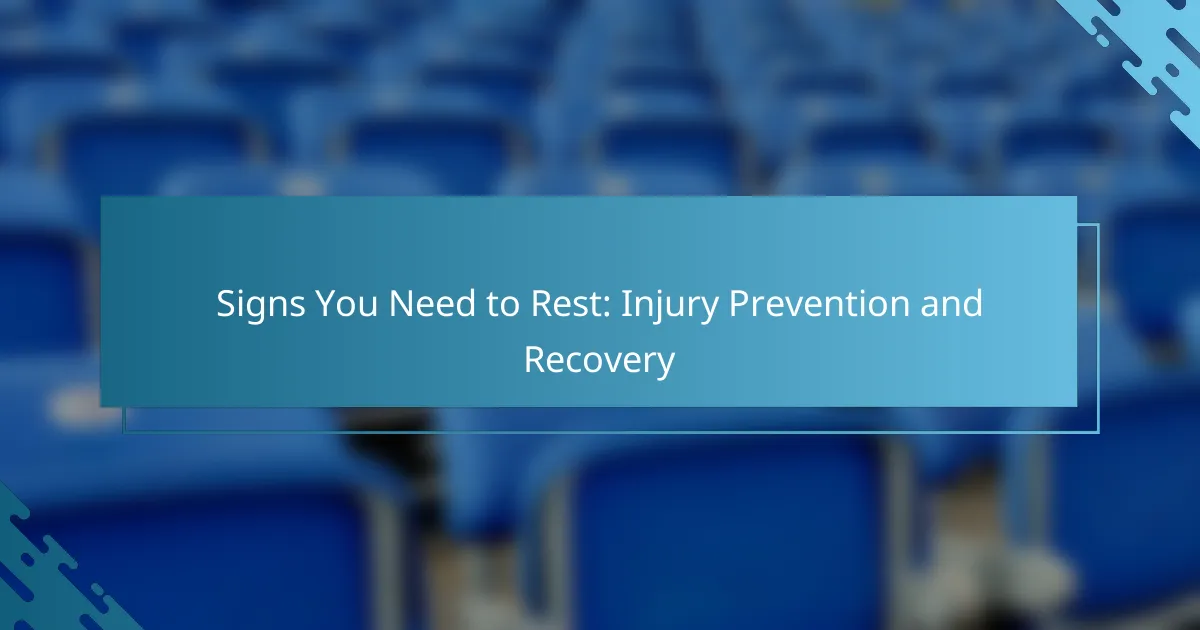Recognizing the signs that indicate a need for rest is crucial for preventing injuries and promoting recovery. Persistent fatigue, increased pain, and decreased performance are key indicators that your body may be signaling for a break. Prioritizing rest not only aids in recovery but also helps maintain optimal performance and reduces the risk of future injuries.

What Are the Signs You Need to Rest?
Recognizing the signs that indicate a need for rest is crucial for injury prevention and recovery. Common indicators include persistent fatigue, increased pain levels, frequent injuries, decreased performance, and emotional instability.
Persistent fatigue
Persistent fatigue is a clear signal that your body requires rest. If you find yourself feeling tired even after a full night’s sleep or experiencing a lack of energy during daily activities, it may be time to take a break.
Consider adjusting your schedule to include more rest days or lighter workouts. Listening to your body can prevent burnout and enhance overall performance in the long run.
Increased pain levels
Increased pain levels, especially if they persist beyond normal soreness, indicate that your body is struggling to recover. This could manifest as joint pain, muscle soreness, or other discomforts that don’t subside with typical recovery practices.
Pay attention to any pain that escalates during activity. If you experience sharp or chronic pain, it’s advisable to rest and consult a healthcare professional to avoid further injury.
Frequent injuries
Frequent injuries, such as strains or sprains, often suggest that your body is not adequately recovering between workouts. If you notice a pattern of injuries, it may be a sign that you are overtraining.
To mitigate this risk, incorporate rest days into your routine and consider cross-training to allow specific muscle groups to recover while still maintaining fitness levels.
Decreased performance
A noticeable decline in performance, such as slower times or reduced strength, can indicate that your body needs rest. If you find that your usual workouts feel more challenging than before, it might be time to reassess your training intensity and recovery practices.
Track your performance metrics and look for trends. If you consistently see a drop in your abilities, prioritize rest and recovery to regain your previous levels.
Emotional instability
Emotional instability, including increased irritability or mood swings, can be a sign of physical exhaustion. Mental fatigue often accompanies physical strain, and both can hinder your overall well-being.
Take note of your emotional responses during training. If you feel unusually stressed or overwhelmed, consider taking a step back to recharge mentally and physically, which can improve both your mood and performance.

How Can Rest Aid Injury Prevention?
Rest is essential for injury prevention as it allows the body to recover and repair itself, reducing the likelihood of injuries. Adequate rest helps maintain optimal performance and keeps the body functioning efficiently, minimizing wear and tear on muscles and joints.
Reduces risk of overuse injuries
Overuse injuries occur when repetitive stress is placed on muscles and joints without sufficient recovery time. Taking regular breaks and incorporating rest days into your training schedule can significantly lower the risk of these injuries. For example, alternating high-intensity workouts with lighter activities or rest days can help prevent strain on specific muscle groups.
Listening to your body is crucial; if you experience persistent pain or discomfort, it may be a sign that you need to rest. Implementing a structured training plan that includes rest periods can help balance activity and recovery, promoting long-term health.
Enhances muscle recovery
Rest is vital for muscle recovery, allowing the body to repair damaged tissues and replenish energy stores. During rest, the body undergoes processes such as protein synthesis, which is essential for muscle growth and repair. Aim for at least 48 hours of recovery for the same muscle group after intense workouts to optimize recovery.
Incorporating active recovery, such as light stretching or low-intensity activities, can further enhance muscle recovery without overexerting yourself. This approach helps maintain blood flow to the muscles, promoting healing while still allowing for rest.
Improves mental focus
Rest not only benefits physical health but also enhances mental focus and cognitive function. Fatigue can lead to decreased concentration, slower reaction times, and impaired decision-making, which can increase the risk of injury during physical activities. Ensuring adequate rest helps maintain mental clarity and sharpness.
To improve mental focus, consider implementing short breaks during training sessions and ensuring you get enough sleep each night. Aiming for 7-9 hours of quality sleep can significantly boost your overall performance and reduce the likelihood of accidents or injuries caused by lapses in concentration.

What Are Effective Recovery Strategies?
Effective recovery strategies are essential for injury prevention and enhancing overall performance. These methods help the body repair itself, reduce fatigue, and prepare for future physical activities.
Active recovery techniques
Active recovery techniques involve low-intensity exercises that promote blood flow and reduce muscle stiffness. Activities such as walking, cycling at a leisurely pace, or gentle yoga can facilitate recovery without putting additional strain on the body.
Incorporating active recovery into your routine can be beneficial after intense workouts. Aim for sessions lasting about 20-30 minutes, focusing on movements that feel comfortable and enjoyable.
Proper hydration
Proper hydration is crucial for recovery as it helps maintain optimal bodily functions and aids in nutrient transport. Drinking water before, during, and after exercise can prevent dehydration, which can hinder recovery and performance.
A general guideline is to consume at least 2-3 liters of water daily, adjusting based on activity level and climate. Electrolyte-rich drinks can also be beneficial after prolonged or intense workouts to replenish lost minerals.
Nutrition for recovery
Nutrition plays a vital role in recovery, providing the necessary nutrients for muscle repair and energy replenishment. Focus on a balanced diet that includes proteins, carbohydrates, and healthy fats to support recovery processes.
Post-exercise meals should ideally be consumed within 30-60 minutes and can include options like a protein shake, yogurt with fruit, or a chicken salad. Aim for a ratio of about 3:1 carbohydrates to protein to optimize recovery and muscle synthesis.

When Should You Seek Professional Help?
If you experience ongoing discomfort or limitations in your physical activities, it may be time to consult a healthcare professional. Recognizing the signs that indicate the need for professional assistance can help prevent further injury and support effective recovery.
Severe or persistent pain
Severe or persistent pain is a clear signal that something may be wrong. If you find that pain lasts for several days or intensifies during normal activities, it’s crucial to seek medical advice. Ignoring such pain can lead to more serious issues down the line.
Consider the type of pain you are experiencing. Sharp, stabbing pain or a dull ache that doesn’t subside could indicate an underlying problem that requires intervention. Keeping a pain diary can help track your symptoms and provide valuable information to your healthcare provider.
Inability to perform daily activities
If you struggle to complete daily tasks due to discomfort or physical limitations, it’s a strong indicator that professional help is needed. This includes difficulties with basic movements such as walking, lifting, or even sitting comfortably.
Assess how your condition affects your quality of life. If simple activities like grocery shopping or climbing stairs become challenging, do not hesitate to consult a healthcare professional. Early intervention can often lead to quicker recovery and a return to normalcy.
Signs of serious injury
Look for signs that may indicate a serious injury, such as swelling, bruising, or inability to move a joint. These symptoms often require prompt evaluation to prevent long-term damage. If you notice any deformities or experience sudden weakness, seek immediate medical attention.
Other warning signs include numbness, tingling, or loss of function in any part of your body. These symptoms can suggest nerve or muscle damage, which should be assessed by a professional as soon as possible to determine the appropriate course of action.

What Are the Best Practices for Resting?
Effective resting practices are essential for injury prevention and recovery. Prioritizing rest helps the body heal, reduces the risk of overuse injuries, and enhances overall performance.
Incorporating rest days
Rest days are crucial for allowing muscles and joints to recover. Aim for at least one full rest day per week, especially after intense training sessions. You can also incorporate active recovery days with light activities like walking or yoga.
Consider scheduling rest days around your most demanding workouts. For example, if you have a heavy lifting session on a Monday, plan a rest day for Tuesday to maximize recovery.
Listening to your body
Pay attention to signs of fatigue, pain, or discomfort. If you feel unusually sore or fatigued, it may be time to take a break. Ignoring these signals can lead to more severe injuries.
Keep a journal to track how your body feels during workouts. This can help you identify patterns and determine when to rest or modify your training routine.
Setting realistic goals
Establish achievable fitness goals that consider your current fitness level and recovery needs. Setting overly ambitious targets can lead to burnout and injuries. Aim for gradual progress rather than drastic changes.
Use the SMART criteria (Specific, Measurable, Achievable, Relevant, Time-bound) to set your goals. For instance, instead of aiming to run a marathon in a month, set a goal to run a 5K in three months, allowing for adequate rest and training time.

How Does Sleep Impact Recovery?
Sleep plays a crucial role in recovery by allowing the body to repair tissues, regulate hormones, and restore energy levels. Quality sleep enhances muscle recovery, reduces inflammation, and improves overall performance.
Importance of Sleep Stages
During sleep, the body cycles through various stages, including REM and deep sleep, each contributing to different recovery processes. Deep sleep is particularly vital for physical recovery, as it promotes muscle repair and growth hormone release. Aim for 7-9 hours of quality sleep to maximize these benefits.
Effects of Sleep Deprivation
Lack of sleep can significantly hinder recovery, leading to increased fatigue, decreased performance, and a higher risk of injury. Studies suggest that even one night of poor sleep can impair cognitive function and physical performance. Prioritize consistent sleep patterns to avoid these negative effects.
Strategies for Better Sleep
To improve sleep quality, establish a regular sleep schedule, create a comfortable sleep environment, and limit screen time before bed. Consider relaxation techniques such as meditation or deep breathing exercises to help wind down. Avoid caffeine and heavy meals close to bedtime to promote restful sleep.
